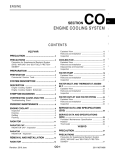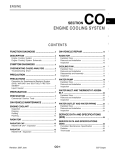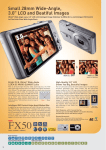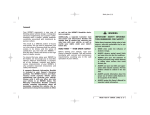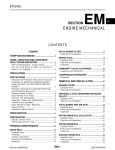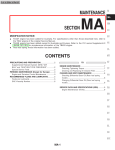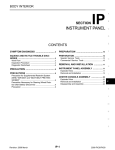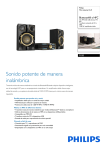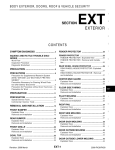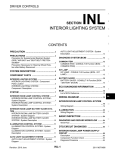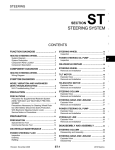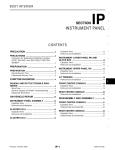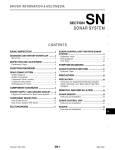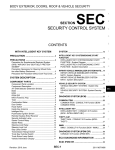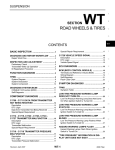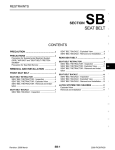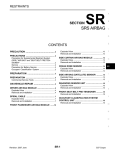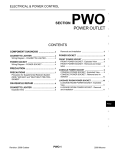Download "service manual"
Transcript
ENGINE SECTION CO ENGINE COOLING SYSTEM A CO C D E CONTENTS VQ35HR F SYSTEM DESCRIPTION .............................. 3 Exploded View .........................................................14 Removal and Installation .........................................14 Inspection ................................................................16 DESCRIPTION .................................................... 3 COOLING FAN .................................................. 17 Engine Cooling System ........................................... 3 Engine Cooling System Schematic ......................... 3 H SYMPTOM DIAGNOSIS ............................... 4 Exploded View .........................................................17 Removal and Installation .........................................17 Disassembly and Assembly .....................................17 Inspection ................................................................18 OVERHEATING CAUSE ANALYSIS .................. 4 WATER PUMP .................................................. 19 Troubleshooting Chart .............................................. 4 Exploded View .........................................................19 Removal and Installation .........................................19 Inspection ................................................................21 I PRECAUTION ............................................... 6 PRECAUTIONS ................................................... 6 Precaution for Supplemental Restraint System (SRS) "AIR BAG" and "SEAT BELT PRE-TENSIONER" ................................................................... 6 Exploded View .........................................................22 Removal and Installation .........................................22 Inspection ................................................................23 K WATER OUTLET AND WATER PIPING .......... 24 L Exploded View .........................................................24 Removal and Installation .........................................24 Inspection ................................................................25 M SERVICE DATA AND SPECIFICATIONS (SDS) ............................................................ 26 N Commercial Service Tools ....................................... 7 PERIODIC MAINTENANCE .......................... 8 ENGINE COOLANT ............................................ 8 Inspection .................................................................. 8 Draining ..................................................................... 8 Refilling ..................................................................... 9 Flushing ................................................................... 10 SERVICE DATA AND SPECIFICATIONS (SDS) ................................................................. 26 Periodical Maintenance Specification ....................26 Radiator ...................................................................26 Thermostat ..............................................................26 RADIATOR .........................................................12 RADIATOR CAP ........................................................ 12 RADIATOR CAP : Inspection .................................. 12 RADIATOR ................................................................ 12 RADIATOR : Inspection .......................................... 12 VK50VE DESCRIPTION .................................................. 27 Engine Cooling System ..........................................27 Engine Cooling System Schematic .......................28 RADIATOR .........................................................14 CO-1 O P SYSTEM DESCRIPTION ............................. 27 REMOVAL AND INSTALLATION ............... 14 Revision: 2009 March J WATER INLET AND THERMOSTAT ASSEMBLY .................................................................... 22 PREPARATION ............................................ 7 PREPARATION ................................................... 7 G 2009 FX35/FX50 SYMPTOM DIAGNOSIS ............................. 29 REMOVAL AND INSTALLATION .............. 39 OVERHEATING CAUSE ANALYSIS ................ 29 RADIATOR ........................................................ 39 Troubleshooting Chart ........................................... 29 PRECAUTION ............................................. 31 Exploded View ........................................................ 39 Removal and Installation ......................................... 39 Inspection ................................................................ 41 PRECAUTIONS ................................................. 31 COOLING FAN .................................................. 42 Precaution for Supplemental Restraint System (SRS) "AIR BAG" and "SEAT BELT PRE-TENSIONER" ................................................................. 31 Exploded View ........................................................ 42 Removal and Installation ......................................... 42 Disassembly and Assembly .................................... 42 Inspection ................................................................ 43 PREPARATION ........................................... 32 PREPARATION ................................................. 32 Commercial Service Tools .................................... 32 PERIODIC MAINTENANCE ........................ 33 ENGINE COOLANT ........................................... 33 Inspection ............................................................... 33 Draining .................................................................. 33 Refilling ................................................................... 34 Flushing .................................................................. 35 RADIATOR ........................................................ 37 RADIATOR CAP ....................................................... 37 RADIATOR CAP : Inspection ................................. 37 RADIATOR ................................................................ 37 RADIATOR : Inspection .......................................... 37 Revision: 2009 March WATER PUMP ................................................... 44 Exploded View ........................................................ 44 Removal and Installation ......................................... 44 Inspection ................................................................ 45 WATER INLET AND THERMOSTAT ASSEMBLY .................................................................... 46 Exploded View ........................................................ 46 Removal and Installation ......................................... 46 Inspection ................................................................ 47 SERVICE DATA AND SPECIFICATIONS (SDS) .......................................................... 49 SERVICE DATA AND SPECIFICATIONS (SDS) ................................................................. 49 Periodical Maintenance Specification .................... 49 Radiator .................................................................. 49 Thermostat .............................................................. 49 CO-2 2009 FX35/FX50 DESCRIPTION [VQ35HR] < SYSTEM DESCRIPTION > SYSTEM DESCRIPTION A DESCRIPTION Engine Cooling System INFOID:0000000003890718 CO C D E F G H I JPBIA1198GB J Engine Cooling System Schematic INFOID:0000000003890719 K L M N O P JPBIA1199GB Revision: 2009 March CO-3 2009 FX35/FX50 OVERHEATING CAUSE ANALYSIS [VQ35HR] < SYMPTOM DIAGNOSIS > SYMPTOM DIAGNOSIS OVERHEATING CAUSE ANALYSIS Troubleshooting Chart INFOID:0000000003890720 Symptom Check items Water pump malfunction Worn or loose drive belt Thermostat stuck closed Poor heat transfer — Dust contamination or paper clogging Damaged fins — Physical damage Clogged radiator cooling tube Excess foreign material (rust, dirt, sand, etc.) Cooling fan does not operate Reduced air flow High resistance to fan rotation Fan assembly — Damaged fan blades Cooling system parts malfunction Damaged radiator shroud — — — Improper engine coolant mixture ratio — — — Poor engine coolant quality — Engine coolant density Cooling hose Water pump Radiator cap Engine coolant leakage — Loose clamp Cracked hose Poor sealing Loose Poor sealing O-ring for damage, deterioration or improper fitting Insufficient engine coolant Radiator Cracked radiator tank Cracked radiator core Reservoir tank Overflowing reservoir tank Revision: 2009 March CO-4 Exhaust gas leakage into cooling system Cracked reservoir tank Cylinder head deterioration Cylinder head gasket deterioration 2009 FX35/FX50 OVERHEATING CAUSE ANALYSIS [VQ35HR] < SYMPTOM DIAGNOSIS > Symptom Check items High engine rpm under no load Abusive driving Driving in low gear for extended time A CO Driving at extremely high speed — Overload on engine Installed improper size wheels and tires Except cooling system parts malfunction C Powertrain system malfunction — D Dragging brakes Improper ignition timing Blocked bumper E — Installed car brassiere Blocked radiator grille Blocked or restricted air flow Blocked radiator Mud contamination or paper clogging F — — Blocked condenser Installed large fog lamp G Blocked air flow H I J K L M N O P Revision: 2009 March CO-5 2009 FX35/FX50 PRECAUTIONS [VQ35HR] < PRECAUTION > PRECAUTION PRECAUTIONS Precaution for Supplemental Restraint System (SRS) "AIR BAG" and "SEAT BELT PRE-TENSIONER" INFOID:0000000005188066 The Supplemental Restraint System such as “AIR BAG” and “SEAT BELT PRE-TENSIONER”, used along with a front seat belt, helps to reduce the risk or severity of injury to the driver and front passenger for certain types of collision. This system includes seat belt switch inputs and dual stage front air bag modules. The SRS system uses the seat belt switches to determine the front air bag deployment, and may only deploy one front air bag, depending on the severity of a collision and whether the front occupants are belted or unbelted. Information necessary to service the system safely is included in the “SRS AIR BAG” and “SEAT BELT” of this Service Manual. WARNING: • To avoid rendering the SRS inoperative, which could increase the risk of personal injury or death in the event of a collision which would result in air bag inflation, all maintenance must be performed by an authorized NISSAN/INFINITI dealer. • Improper maintenance, including incorrect removal and installation of the SRS, can lead to personal injury caused by unintentional activation of the system. For removal of Spiral Cable and Air Bag Module, see the “SRS AIR BAG”. • Do not use electrical test equipment on any circuit related to the SRS unless instructed to in this Service Manual. SRS wiring harnesses can be identified by yellow and/or orange harnesses or harness connectors. PRECAUTIONS WHEN USING POWER TOOLS (AIR OR ELECTRIC) AND HAMMERS WARNING: • When working near the Air Bag Diagnosis Sensor Unit or other Air Bag System sensors with the ignition ON or engine running, DO NOT use air or electric power tools or strike near the sensor(s) with a hammer. Heavy vibration could activate the sensor(s) and deploy the air bag(s), possibly causing serious injury. • When using air or electric power tools or hammers, always switch the ignition OFF, disconnect the battery, and wait at least 3 minutes before performing any service. Revision: 2009 March CO-6 2009 FX35/FX50 PREPARATION [VQ35HR] < PREPARATION > PREPARATION A PREPARATION Commercial Service Tools INFOID:0000000003890722 Tool name Description Power tool Loosening bolts and nuts CO C D E PBIC0190E Radiator cap tester Checking radiator and radiator cap F G PBIC1982E Radiator cap tester adapter Adapting radiator cap tester to radiator cap and water outlet (front) filler neck a: 28 (1.10) dia. b: 31.4 (1.236) dia. c: 41.3 (1.626) dia. Unit: mm (in) H I J S-NT564 K L M N O P Revision: 2009 March CO-7 2009 FX35/FX50 ENGINE COOLANT [VQ35HR] < PERIODIC MAINTENANCE > PERIODIC MAINTENANCE ENGINE COOLANT Inspection INFOID:0000000003890723 LEVEL • Check if the reservoir tank engine coolant level is within the “MIN” to “MAX” when the engine is cool. A : MAX B : MIN • Adjust the engine coolant level as necessary. • Check that the reservoir tank cap is tightened. JPBIA0102ZZ LEAKAGE • To check for leakage, apply pressure to the cooling system with the radiator cap tester and radiator cap tester adapter (commercial service tool) (A). Testing pressure : Refer to CO-49, "Radiator". WARNING: Never remove radiator cap when engine is hot. Serious burns could occur from high-pressure engine coolant escaping from water outlet (front). CAUTION: Higher test pressure than specified may cause radiator damage. NOTE: In a case that engine coolant decreases, fill radiator with engine coolant. • If anything is found, repair or replace damaged parts. Draining JPBIA0411ZZ INFOID:0000000003890724 WARNING: • Never change engine coolant when the engine is hot to avoid being scalded. • Wrap a thick cloth around radiator cap and carefully remove radiator cap. First, turn radiator cap a quarter of a turn to release built-up pressure. Then turn radiator cap all the way. 1. Open radiator drain plug (2) at the bottom of radiator, and then remove radiator cap. 1 : Engine under cover A : Radiator drain plug hole : Vehicle front JPBIA0259ZZ When draining all of engine coolant in the system, open water drain plugs on cylinder block. Refer to EM-92, "Setting". 2. 3. Remove reservoir tank as necessary, and drain engine coolant and clean reservoir tank before installing. Check drained engine coolant for contaminants such as rust, corrosion or discoloration. Revision: 2009 March CO-8 2009 FX35/FX50 ENGINE COOLANT < PERIODIC MAINTENANCE > If contaminated, flush the engine cooling system. Refer to CO-10, "Flushing". A Refilling 1. 2. [VQ35HR] INFOID:0000000003890725 Remove engine cover. Refer to EM-27, "Exploded View". Install reservoir tank if removed, and radiator drain plug. CAUTION: Be sure to clean drain plug and install with new O-ring. CO C Tightening torque 3. 4. : Refer to CO-14, "Exploded View". If water drain plugs on cylinder block are removed, close and tighten them. Refer to EM-118, "Disassembly and Assembly". Check that each hose clamp is firmly tightened. Remove air relief plug (2) on radiator left side. 1 3 D E : Reservoir tank : Engine cover F : Vehicle front G JPBIA0260ZZ 5. H Remove air relief plug (1) on heater hose. (models with air relief plug on heater hose) I 2 : Heater hose : Vehicle front J K JPBIA0104ZZ 6. Fill radiator, and reservoir tank if removed, to specified level. • Pour engine coolant through engine coolant filler neck slowly of less than 2 (2-1/8 US qt, 1-3/4 lmp qt) a minute to allow air in system to escape. • Use Genuine NISSAN Long Life Antifreeze/Coolant or an equivalent mixed with water (distilled or demineralized). Refer to MA-12, "Fluids and Lubricants". L M N Engine coolant capacity (With reservoir tank at “MAX” level) : Refer to CO-26, "Periodical Maintenanc e Specification". JPBIA0412ZZ O P Revision: 2009 March CO-9 2009 FX35/FX50 ENGINE COOLANT [VQ35HR] < PERIODIC MAINTENANCE > Reservoir tank engine coolant capacity (At “MAX” level) A : MAX B : MIN :Refer to CO-26, "Periodical Maintenanc e Specification". JPBIA0102ZZ 7. When engine coolant overflows air relief hole on radiator, install air relief plug with new O-ring. Tightening torque 8. 9. : Refer to CO-14, "Exploded View". Repeat step 6. When engine coolant overflows air relief hole on heater hose, install air relief plug with new O-ring. Then refill radiator with engine coolant. (models with air relief plug on heater hose) : 1.2 N·m (0.12 kg-m, 11 in-lb) 10. Install radiator cap. 11. Warm up engine until opening thermostat. Standard for warming-up time is approximately 10 minutes at 3,000 rpm. • Check thermostat opening condition by touching radiator hose (lower) to see a flow of warm water. CAUTION: Watch water temperature gauge so as not to overheat engine. 12. Stop the engine and cool down to less than approximately 50°C (122°F). • Cool down using fan to reduce the time. • If necessary, refill radiator up to filler neck with engine coolant. 13. Refill reservoir tank to “MAX” level line with engine coolant. 14. Repeat steps 10 through 13 two or more times with radiator cap installed until engine coolant level no longer drops. 15. Check cooling system for leakage with engine running. 16. Warm up the engine, and check for sound of engine coolant flow while running engine from idle up to 3,000 rpm with heater temperature controller set at several position between “COOL” and “WARM”. • Sound may be heard from the heater unit. 17. Repeat step 16 three times. 18. If sound is heard, bleed air from cooling system by repeating step 6, and steps from 10 to 17 until engine coolant level no longer drops. 19. Check that the reservoir tank cap is tightened. Flushing 1. INFOID:0000000003890726 Install reservoir tank if removed, and radiator drain plug. CAUTION: Be sure to clean drain plug and install with new O-ring. Tightening torque : Refer to CO-14, "Exploded View". If water drain plugs on cylinder block are removed, close and tighten them. Refer to EM-118, "Disassembly and Assembly". Revision: 2009 March CO-10 2009 FX35/FX50 ENGINE COOLANT < PERIODIC MAINTENANCE > 2. Remove air relief plug (1) on heater hose. (models with air relief plug on heater hose) 2 [VQ35HR] A : Heater hose CO : Vehicle front C JPBIA0104ZZ D 3. Remove air relief plug (2) on radiator. 1 : Reservoir tank 3 : Engine cover E : Vehicle front F G JPBIA0260ZZ 4. Fill radiator with water until water spills from the air relief holes, then close air relief plugs. Fill radiator and reservoir tank with water and reinstall radiator cap. Tightening torque 5. 6. 7. 8. 9. 10. : Refer to CO-14, "Exploded View". H I Run the engine and warm it up to normal operating temperature. Rev the engine two or three times under no-load. Stop the engine and wait until it cools down. Drain water from the system. Refer to CO-8, "Draining". Repeat steps 1 through 8 until clear water begins to drain from radiator. Check that the reservoir tank cap is tightened. J K L M N O P Revision: 2009 March CO-11 2009 FX35/FX50 RADIATOR [VQ35HR] < PERIODIC MAINTENANCE > RADIATOR RADIATOR CAP RADIATOR CAP : Inspection INFOID:0000000003890727 • Check valve seat of radiator cap. - Check if valve seat (A) is swollen to the extent that the edge of the metal plunger (B) cannot be seen when watching it vertically from the top. - Check if valve seat has no soil and damage. JPBIA0108ZZ • Pull negative-pressure valve to open it, and check that it close completely when released. - Check that there is no dirt or damage on the valve seat of radiator cap negative-pressure valve. - Check that there are no unusualness in the opening and closing conditions of negative-pressure valve. SMA967B • Check radiator cap relief pressure. - When connecting radiator cap to the radiator cap tester (commercial service tool) and the radiator cap tester adapter (commercial service tool) (A), apply engine coolant to the cap seal surface. Standard and limit : Refer to CO-26, "Radiator". JPBIA0109ZZ • Replace radiator cap if there is an unusualness related to the above three. CAUTION: When installing radiator cap, thoroughly wipe out the water outlet (front) filler neck to remove any waxy residue or foreign material. RADIATOR RADIATOR : Inspection INFOID:0000000003890728 Check radiator for mud or clogging. If necessary, clean radiator as per the following: • Be careful not to bend or damage radiator fins. • When radiator is cleaned without removal, remove all surrounding parts such as radiator cooling fan assembly and horns. Then tape harness and connectors to prevent water from entering. 1. Apply water by hose to the back side of the radiator core vertically downward. 2. Apply water again to all radiator core surfaces once per minute. Revision: 2009 March CO-12 2009 FX35/FX50 RADIATOR [VQ35HR] < PERIODIC MAINTENANCE > 3. Stop washing if any stains no longer flow out from radiator. 4. Blow air into the back side of radiator core vertically downward. • Use compressed air lower than 490 kPa (5 kg/cm2, 71 psi) and keep distance more than 30 cm (11.8 in). 5. Blow air again into all the radiator core surfaces once per minute until no water sprays out. A CO C D E F G H I J K L M N O P Revision: 2009 March CO-13 2009 FX35/FX50 RADIATOR [VQ35HR] < REMOVAL AND INSTALLATION > REMOVAL AND INSTALLATION RADIATOR Exploded View INFOID:0000000003890729 JPBIA1831GB 1. Upper mount bracket 2. Mounting rubber (upper) 3. Radiator 4. Mounting rubber (lower) 5. Clamp 6. Radiator hose (lower) 7. Radiator hose (upper) 8. Drain plug 9. O-ring 10. Water drain hose 11. O-ring 12. Air relief plug 13. Clamp 14. A/T fluid cooler hose 15. A/T fluid cooler hose 16. Cooling fan assembly 17. Grommet 18. Reservoir tank 19. Reservoir tank hose 20. Reservoir tank hose 21. Clamp B. C. 22. Reservoir tank cap A. To water outlet (front) D. To A/T fluid cooler pipe To water inlet To water outlet (front) Refer to GI-4, "Components" for symbols in the figure. Removal and Installation INFOID:0000000003890730 REMOVAL Revision: 2009 March CO-14 2009 FX35/FX50 RADIATOR [VQ35HR] < REMOVAL AND INSTALLATION > WARNING: Never remove radiator cap when engine is hot. Serious burns could occur from high-pressure engine A coolant escaping from water outlet (front). Wrap a thick cloth around the cap. Slowly turn it a quarter of a turn to release built-up pressure. Carefully remove radiator cap by turning it all the way. 1. Remove the following parts: CO • Engine under cover with power tool. • Engine cover: Refer to EM-27, "Exploded View". • Air cleaner case: Refer to EM-29, "Exploded View". C • Air duct (inlet): Refer to EM-29, "Exploded View". • Hood lock stay assembly and horn: Refer to DLK-232, "Exploded View" and HRN-6, "Exploded View". 2. Remove condenser. Refer to HA-47, "Exploded View". D 3. Drain engine coolant from radiator. Refer to CO-8, "Draining". CAUTION: • Perform this step when the engine is cold. • Never spill engine coolant on drive belt. E 4. Disconnect A/T fluid cooler hoses from radiator. • Install blind plug to avoid leakage of A/T fluid. 5. Remove radiator hoses (upper and lower) and reservoir tank hose. F CAUTION: • Be careful not to allow engine coolant to contact drive belt. • Never loosen radiator water inlet pipe mounting screw G (A). If loosened, replace radiator (1). 2 : Radiator water inlet pipe H I JPBIA1832ZZ 6. Rotate two radiator upper mount brackets 90 degrees in direction as shown in the figure, and remove them. 1 : Radiator upper mount bracket A : Turn 90° counterclockwise J K L M JPBIA0105ZZ 7. a. N Remove radiator as per the following: CAUTION: Be careful not to damage radiator core. Lift up and pull the radiator (1) forward, and then remove the mounting rubber (lower) (3) from the radiator core support (2). O P : Vehicle front JPBIA0106ZZ Revision: 2009 March CO-15 2009 FX35/FX50 RADIATOR [VQ35HR] < REMOVAL AND INSTALLATION > b. Remove radiator (1) from front of radiator core support (2). : Vehicle front JPBIA0107ZZ INSTALLATION Installation is the reverse order of removal. Inspection INFOID:0000000003890731 INSPECTION AFTER INSTALLATION • Check for leakage of engine coolant using the radiator cap tester adapter (commercial service tool) and the radiator cap tester (commercial service tool). Refer to CO-33, "Inspection". • Start and warm up the engine. Visually check that there is no leakage of engine coolant and A/T fluid. Revision: 2009 March CO-16 2009 FX35/FX50 COOLING FAN [VQ35HR] < REMOVAL AND INSTALLATION > COOLING FAN A Exploded View INFOID:0000000003890732 CO C D E F G JPBIA1833GB 1. Cooling fan (RH) 2. Cooling fan (LH) 3. Fan shroud 4. Fan motor (LH) 5. Fan motor (RH) 6. Cooling fan control module 7. Grommet A. Apply on fan motor shaft H I : Apply high strength thread locking sealant or equivalent. Refer to GI-4, "Components" for symbols not described on the above. Removal and Installation INFOID:0000000003890733 REMOVAL 1. 2. 3. 4. 5. 6. 7. Drain engine coolant. Refer to CO-8, "Draining". Remove reservoir tank. Refer to CO-39, "Exploded View". Remove air cleaner case (bank 1 and bank 2). Refer to EM-29, "Exploded View". Remove mounting bolt from high pressure flexible hose bracket. Refer to HA-40, "Exploded View". Remove radiator hose (upper). Refer to CO-14, "Exploded View". Disconnect harness connector from cooling fan control module, and move harness to aside. Remove cooling fan assembly. CAUTION: Be careful not to damage or scratch on radiator core. J K L M N INSTALLATION Note the following, and install in the reverse order of removal. CAUTION: Only use genuine parts for cooling fan mounting bolt and observe the specified torque (to prevent radiator from being damaged). Disassembly and Assembly INFOID:0000000003890734 DISASSEMBLY 1. 2. Disconnect harness connector from cooling fan control module. Remove cooling fan control module from cooling fan assembly. CAUTION: Handle carefully to avoid dropping and impact. Revision: 2009 March CO-17 2009 FX35/FX50 O P COOLING FAN [VQ35HR] < REMOVAL AND INSTALLATION > 3. Remove cooling fan mounting nuts, and then remove the cooling fan (RH and LH). 4. Remove fan motors (RH and LH). ASSEMBLY Note the following, and assemble in the reverse order of disassembly. CAUTION: RH and LH cooling fans are different. Be careful not to misassemble them. • Install each fan in the following position. Right side Left side : 9 blades : 11 blades • Secure the harness tightly to the fan shroud to prevent the fan rotation area from being slack. Inspection INFOID:0000000003890735 INSPECTION AFTER REMOVAL Check that fan motors operate normally. NOTE: Cooling fans are controlled by cooling fan control module. For details, refer to EC-466, "Description". INSPECTION AFTER DISASSEMBLY Cooling Fan Inspect cooling fan for crack or unusual bend. • If anything is found, replace cooling fan. Revision: 2009 March CO-18 2009 FX35/FX50 WATER PUMP [VQ35HR] < REMOVAL AND INSTALLATION > WATER PUMP A Exploded View INFOID:0000000003890736 CO C D E F G JPBIA0270GB 1. Timing chain tensioner (primary) 4. O-ring A. Identify with yellow paint mark 2. Water pump 3. O-ring H B. Identify with light blue paint mark Apply engine coolant I Refer to GI-4, "Components" for symbols in the figure. Removal and Installation INFOID:0000000003890737 J CAUTION: • When removing water pump assembly, be careful not to get engine coolant on drive belt. • Water pump cannot be disassembled and should be replaced as a unit. • After installing water pump, connect hose and clamp securely, then check for leakage using the radiator cap tester (commercial service tool) and the radiator cap tester adapter (commercial service tool). K REMOVAL L 1. 2. 3. 4. 5. 6. 7. 8. Remove engine cover. Refer to EM-27, "Exploded View". Release the fuel pressure. Refer to EC-567, "Inspection". Disconnect the battery cable from the negative terminal. Remove air duct and air cleaner case assembly (bank 1 and bank 2). Refer to EM-29, "Exploded View". Remove reservoir tank. Refer to CO-39, "Exploded View". Separate engine harness removing their brackets from front timing chain case. Remove engine undercover with power tool. Drain engine oil. Refer to LU-8, "Draining". CAUTION: • Perform this step when the engine is cold. • Never spill engine oil on drive belt. 9. Drain engine coolant from radiator. Refer to CO-8, "Draining". CAUTION: • Perform this step when the engine is cold. • Never spill engine coolant on drive belt. 10. Remove radiator hose (lower). Refer to CO-14, "Exploded View". 11. Remove cooling fan assembly. Refer to CO-17, "Exploded View". 12. Remove front timing chain case. Refer to EM-53, "Exploded View". Revision: 2009 March CO-19 2009 FX35/FX50 M N O P WATER PUMP < REMOVAL AND INSTALLATION > 13. Remove timing chain tensioner (primary) as per the following: a. Remove lower mounting bolt (A). b. Loosen upper mounting bolt (B) slowly, and then turn chain tensioner (primary) (1) on the upper mounting bolt so that plunger (C) is fully expanded. NOTE: Even if plunger is fully expanded, it is not dropped from the body of timing chain tensioner (primary). [VQ35HR] JPBIA1537ZZ c. Remove upper mounting bolt, and then remove timing chain tensioner (primary). 14. Remove water pump as per the following: a. Remove three water pump mounting bolts. Secure a gap between water pump gear and timing chain, by turning crankshaft counterclockwise until timing chain looseness on water pump sprocket becomes maximum. b. c. Screw M8 bolts (A) [pitch: 1.25 mm (0.0492 in) length: approximately 50 mm (1.97 in)] into water pumps upper and lower mounting bolt holes until they reach timing chain case. Then, alternately tighten each bolt for a half turn, and pull out water pump (1). CAUTION: • Pull straight out while preventing vane from contacting socket in installation area. • Remove water pump without causing sprocket to contact timing chain. Remove M8 bolts and O-rings from water pump. CAUTION: Never disassemble water pump. JPBIA0111ZZ INSTALLATION 1. Install new O-rings to water pump. • Apply engine oil to O-ring (1) and engine coolant to O-ring (3) as shown in the figure. 2 : Water pump • Locate O-ring with yellow paint mark (A) to front side. • Locate O-ring with light blue paint mark (B) to rear side. JPBIA0112ZZ 2. Install water pump. CAUTION: Never allow cylinder block to nip O-rings when installing water pump. • Check timing chain and water pump sprocket are engaged. • Insert water pump by tightening mounting bolts alternately and evenly. 3. a. Install timing chain tensioner (primary) as per the following: Turn crankshaft clockwise so that timing chain on the timing chain tensioner (primary) side is loose. Revision: 2009 March CO-20 2009 FX35/FX50 WATER PUMP [VQ35HR] < REMOVAL AND INSTALLATION > b. Pull plunger stopper tab (A) up (or turn lever downward) so as to remove plunger stopper tab from the ratchet of plunger (D). A NOTE: Plunger stopper tab and lever (C) are synchronized. c. Push plunger into the inside of tensioner body. CO d. Hold plunger in the fully compressed position by engaging plunger stopper tab with the tip of ratchet. e. To secure lever, insert stopper pin (E) through hole of lever into C tensioner body hole (B). • The lever parts and the tab are synchronized. Therefore, the JPBIA0118ZZ plunger will be secured under this condition. D NOTE: Figure shows the example of 1.2 mm (0.047 in) diameter thin screwdriver being used as the stopper pin. f. Install timing chain tensioner (primary). • Remove dust and foreign material completely from backside of timing chain tensioner (primary) and E from installation area of rear timing chain case. g. Remove stopper pin. F h. 4. Check again that timing chain and water pump sprocket are engaged. Install in the reverse order of removal for remaining parts. • After starting engine, let idle for three minutes, then rev engine up to 3,000 rpm under no load to purge air from the high-pressure chamber of chain tensioner. Engine may produce a rattling noise. This indicates that air still remains in the chamber and is not a matter of concern. G H Inspection INFOID:0000000003890738 INSPECTION AFTER REMOVAL I • Check for badly rusted or corroded water pump body assembly. • Check for rough operation due to excessive end play. • If anything is found, replace water pump. J K L SLC943A INSPECTION AFTER INSTALLATION M • Check that the reservoir tank cap is tightened. • Check for leakage of engine coolant using the radiator cap tester adapter (commercial service tool) and the radiator cap tester (commercial service tool). Refer to CO-33, "Inspection". • Start and warm up the engine. Visually check that there is no leakage of engine coolant. N O P Revision: 2009 March CO-21 2009 FX35/FX50 WATER INLET AND THERMOSTAT ASSEMBLY [VQ35HR] < REMOVAL AND INSTALLATION > WATER INLET AND THERMOSTAT ASSEMBLY Exploded View INFOID:0000000003890739 JPBIA1466GB 1. Gasket 2. Water inlet and thermostat assembly Refer to GI-4, "Components" for symbols in the figure. Removal and Installation INFOID:0000000003890740 REMOVAL 1. 2. 3. 4. 5. 6. 7. 8. Remove engine cover. Refer to EM-27, "Exploded View". Remove air duct and air cleaner case assembly (bank 2). Refer to EM-29, "Exploded View". Remove reservoir tank. Refer to CO-14, "Exploded View". Remove engine undercover with power tool. Drain engine coolant from radiator drain plug at the bottom of radiator. Refer to CO-8, "Draining". CAUTION: • Perform this step when the engine is cold. • Never spill engine coolant on drive belt. Disconnect radiator hose (lower). Disconnect intake valve timing control solenoid valve harness connector (bank 2), and remove intake valve timing control solenoid valve. Remove water inlet and thermostat assembly (1). A : Never loosen these screw. CAUTION: Never disassemble water inlet and thermostat assembly. Replace them as a unit, if necessary. JPBIA0261ZZ INSTALLATION Note the following, and install in the reverse order of removal. • Be careful not to spill engine coolant over engine room. Use rag to absorb engine coolant. Revision: 2009 March CO-22 2009 FX35/FX50 WATER INLET AND THERMOSTAT ASSEMBLY [VQ35HR] < REMOVAL AND INSTALLATION > Inspection INFOID:0000000003890741 A INSPECTION AFTER REMOVAL 1. 2. Check valve seating condition at ordinary room temperatures. It should seat tightly. Check valve operation. Thermostat (Standard) CO : Refer to CO-26, "Thermostat". C • If the malfunctioning condition, when valve seating at ordinary room temperature, or measured values are out of the standard, replace water inlet and thermostat assembly. D E SLC949A INSPECTION AFTER INSTALLATION • Check that the reservoir tank cap is tightened. • Check for leakage of engine coolant using the radiator cap tester adapter (commercial service tool) and the radiator cap tester (commercial service tool). Refer to CO-8, "Inspection". • Start and warm up the engine. Visually check that there is no leakage of engine coolant. F G H I J K L M N O P Revision: 2009 March CO-23 2009 FX35/FX50 WATER OUTLET AND WATER PIPING [VQ35HR] < REMOVAL AND INSTALLATION > WATER OUTLET AND WATER PIPING Exploded View INFOID:0000000003890742 JPBIA2319GB 1. Clamp 2. Water hose 3. Harness bracket 4. Engine coolant temperature sensor 5. Heater hose 6. Clamp 7. Water outlet (rear) 8. Gasket 9. O-ring 10. Water outlet pipe 11. Water outlet (front) 12. Radiator cap 13. Clamp 14. Radiator hose (upper) 15. Gasket 16. Water pipe 17. Clamp 18. Water hose 19. Water hose 20. Gasket 21. Heater pipe 22. Clamp 23. Water hose 24. Water hose 25. Water bypass pipe 26. O-ring 27. Heater hose C. A. To electric throttle control actuator (bank 1) B. To heater core D. To oil cooler E. To electric throttle control actuator (bank 2) To radiator Refer to GI-4, "Components" for symbols in the figure. Removal and Installation INFOID:0000000003890743 REMOVAL 1. 2. Remove engine undercover with power tool. Drain engine coolant from drain plugs on radiator and cylinder block. Refer to CO-8, "Draining" and EM92, "Setting". CAUTION: • Perform this step when the engine is cold. Revision: 2009 March CO-24 2009 FX35/FX50 WATER OUTLET AND WATER PIPING < REMOVAL AND INSTALLATION > • Never spill engine coolant on drive belt. 3. Remove engine cover. Refer to EM-27, "Exploded View". 4. Remove air duct and air cleaner case assembly. Refer to EM-29, "Exploded View". 5. Remove intake manifold collector. Refer to EM-31, "Exploded View". 6. Remove intake manifold. Refer to EM-34, "Exploded View". 7. Remove reservoir tank. Refer to CO-14, "Exploded View". 8. Remove oil level gauge and guide. Refer to EM-46, "Exploded View". 9. Remove radiator hose (upper) and heater hose. 10. Remove water outlet (front) and water outlet pipe. 11. Remove water outlet (rear). 12. Separate engine harness removing their bracket from water outlet (rear). 13. Remove engine coolant temperature sensor if necessary. CAUTION: Be careful not to damage engine coolant temperature sensor. 14. Remove water pipe, heater pipe, water bypass pipe, and water outlet (rear). [VQ35HR] A CO C D E INSTALLATION F Note the following, and install in the reverse order of removal. • Securely insert each hose, and install clamp at a position where it does not interfere with the pipe bulge. • When inserting water outlet pipe and water bypass pipe into water outlet, apply neutral detergent to O-ring. CAUTION: Never allow water outlet (rear) to nip O-rings when installing water outlet pipe and water bypass pipe. G Inspection H INFOID:0000000003890744 INSPECTION AFTER INSTALLATION • Check that the reservoir tank cap is tightened. • Check for leakage of engine coolant using the radiator cap tester adapter (commercial service tool) and the radiator cap tester (commercial service tool). Refer to CO-8, "Inspection". • Start and warm up the engine. Visually check that there is no leakage of engine coolant. I J K L M N O P Revision: 2009 March CO-25 2009 FX35/FX50 SERVICE DATA AND SPECIFICATIONS (SDS) [VQ35HR] < SERVICE DATA AND SPECIFICATIONS (SDS) SERVICE DATA AND SPECIFICATIONS (SDS) SERVICE DATA AND SPECIFICATIONS (SDS) Periodical Maintenance Specification INFOID:0000000003890745 ENGINE COOLANT CAPACITY (APPROXIMATELY) Unit: Engine coolant capacity [With reservoir tank (“MAX” level)] (US qt, Imp qt) 9.2 (9-3/4, 8-1/8) Reservoir tank engine coolant capacity (At “MAX” level) 0.8 (7/8, 3/4) Radiator INFOID:0000000003890746 Unit: kPa (kg/cm2, psi) Cap relief pressure Standard 122.3 - 151.7 (1.2 - 1.5, 18 - 22) Limit 107 (1.1, 16) Leakage testing pressure 157 (1.6, 23) Thermostat INFOID:0000000003890747 Thermostat Standard Valve opening temperature 82°C (180°F) Maximum valve lift 9.0 mm/95°C (0.354 in/203°F) Valve closing temperature Revision: 2009 March 77°C (171°F) CO-26 2009 FX35/FX50 DESCRIPTION [VK50VE] < SYSTEM DESCRIPTION > SYSTEM DESCRIPTION A DESCRIPTION Engine Cooling System INFOID:0000000003890748 CO C D E F G H I J JPBIA2364GB K L M N O P Revision: 2009 March CO-27 2009 FX35/FX50 DESCRIPTION [VK50VE] < SYSTEM DESCRIPTION > Engine Cooling System Schematic INFOID:0000000003890749 JPBIA2411GB Revision: 2009 March CO-28 2009 FX35/FX50 OVERHEATING CAUSE ANALYSIS [VK50VE] < SYMPTOM DIAGNOSIS > SYMPTOM DIAGNOSIS A OVERHEATING CAUSE ANALYSIS Troubleshooting Chart INFOID:0000000003890750 Symptom Check items Water pump malfunction Poor heat transfer C Worn or loose drive belt Thermostat stuck closed — Dust contamination or paper clogging Damaged fins CO D — Physical damage Clogged radiator cooling tube E Excess foreign material (rust, dirt, sand, etc.) Cooling fan does not operate Reduced air flow High resistance to fan rotation F Fan assembly — Damaged fan blades Cooling system parts malfunction G Damaged radiator shroud — — — Improper engine coolant mixture ratio — — — Poor engine coolant quality — Engine coolant density Cooling hose Water pump Radiator cap Engine coolant leakage — Loose clamp Cracked hose Radiator J Loose Poor sealing Overflowing reservoir tank Exhaust gas leakage into cooling system K Cracked radiator tank Cracked radiator core Reservoir tank I Poor sealing O-ring for damage, deterioration or improper fitting Insufficient engine coolant H Cracked reservoir tank L Cylinder head deterioration Cylinder head gasket deterioration M N O P Revision: 2009 March CO-29 2009 FX35/FX50 OVERHEATING CAUSE ANALYSIS [VK50VE] < SYMPTOM DIAGNOSIS > Symptom Check items High engine rpm under no load Abusive driving Driving in low gear for extended time Driving at extremely high speed — Overload on engine Powertrain system malfunction Installed improper size wheels and tires Except cooling system parts malfunction — Dragging brakes Improper ignition timing Blocked bumper — Installed car brassiere Blocked radiator grille Blocked or restricted air flow Blocked radiator Blocked condenser Installed large fog lamp Revision: 2009 March CO-30 Mud contamination or paper clogging — — Blocked air flow 2009 FX35/FX50 PRECAUTIONS [VK50VE] < PRECAUTION > PRECAUTION A PRECAUTIONS Precaution for Supplemental Restraint System (SRS) "AIR BAG" and "SEAT BELT PRE-TENSIONER" CO INFOID:0000000003902708 The Supplemental Restraint System such as “AIR BAG” and “SEAT BELT PRE-TENSIONER”, used along with a front seat belt, helps to reduce the risk or severity of injury to the driver and front passenger for certain types of collision. This system includes seat belt switch inputs and dual stage front air bag modules. The SRS system uses the seat belt switches to determine the front air bag deployment, and may only deploy one front air bag, depending on the severity of a collision and whether the front occupants are belted or unbelted. Information necessary to service the system safely is included in the “SRS AIR BAG” and “SEAT BELT” of this Service Manual. WARNING: • To avoid rendering the SRS inoperative, which could increase the risk of personal injury or death in the event of a collision which would result in air bag inflation, all maintenance must be performed by an authorized NISSAN/INFINITI dealer. • Improper maintenance, including incorrect removal and installation of the SRS, can lead to personal injury caused by unintentional activation of the system. For removal of Spiral Cable and Air Bag Module, see the “SRS AIR BAG”. • Do not use electrical test equipment on any circuit related to the SRS unless instructed to in this Service Manual. SRS wiring harnesses can be identified by yellow and/or orange harnesses or harness connectors. PRECAUTIONS WHEN USING POWER TOOLS (AIR OR ELECTRIC) AND HAMMERS WARNING: • When working near the Air Bag Diagnosis Sensor Unit or other Air Bag System sensors with the ignition ON or engine running, DO NOT use air or electric power tools or strike near the sensor(s) with a hammer. Heavy vibration could activate the sensor(s) and deploy the air bag(s), possibly causing serious injury. • When using air or electric power tools or hammers, always switch the ignition OFF, disconnect the battery, and wait at least 3 minutes before performing any service. C D E F G H I J K L M N O P Revision: 2009 March CO-31 2009 FX35/FX50 PREPARATION [VK50VE] < PREPARATION > PREPARATION PREPARATION Commercial Service Tools INFOID:0000000003890752 Tool name Description Power tool Loosening bolts and nuts PBIC0190E Radiator cap tester Checking radiator and radiator cap PBIC1982E Radiator cap tester adapter Adapting radiator cap tester to radiator cap and water inlet filler neck a: 28 (1.10) dia. b: 31.4 (1.236) dia. c: 41.3 (1.626) dia. Unit: mm (in) S-NT564 Revision: 2009 March CO-32 2009 FX35/FX50 ENGINE COOLANT [VK50VE] < PERIODIC MAINTENANCE > PERIODIC MAINTENANCE A ENGINE COOLANT Inspection INFOID:0000000003890753 CO LEVEL • Check if the reservoir tank engine coolant level is within the “MIN” to “MAX” when the engine is cool. A : MAX B : MIN C D • Adjust the engine coolant level if necessary. • Check that the reservoir tank cap is tightened. E JPBIA0102ZZ F LEAKAGE • To check for leakage, apply pressure to the cooling system with the radiator cap tester and radiator cap tester adapter (commercial service tool) (A). Testing pressure G : Refer to CO-49, "Radiator". WARNING: Never remove radiator cap when engine is hot. Serious burns could occur from high-pressure engine coolant escaping from water inlet. CAUTION: Higher test pressure than specified may cause radiator damage. NOTE: In a case that engine coolant decreases, fill radiator with engine coolant. • If anything is found, repair or replace damaged parts. Draining H I JPBIA2344ZZ J K INFOID:0000000003890754 WARNING: • Never change engine coolant when the engine is hot to avoid being scalded. • Wrap a thick cloth around radiator cap and carefully remove radiator cap. First, turn radiator cap a quarter of a turn to release built-up pressure. Then turn radiator cap all the way. 1. Open radiator drain plug (2) at the bottom of radiator, and then remove radiator cap. 1 : Engine under cover A : Radiator drain plug hole L M N : Vehicle front O P JPBIA2345ZZ When draining all of engine coolant in the system, open water drain plug on cylinder block. Refer to EM-202, "Setting". 2. 3. Remove reservoir tank if necessary, and drain engine coolant and clean reservoir tank before installing. Check drained engine coolant for contaminants such as rust, corrosion or discoloration. Revision: 2009 March CO-33 2009 FX35/FX50 ENGINE COOLANT < PERIODIC MAINTENANCE > If contaminated, flush the engine cooling system. Refer to CO-35, "Flushing". Refilling 1. 2. [VK50VE] INFOID:0000000003890755 Remove engine cover and engine room cover (LH). Refer to EM-174, "Exploded View". Install reservoir tank if removed, and radiator drain plug. CAUTION: Be sure to clean drain plug and install with new O-ring. : 1.2 N·m (0.12 kg-m, 11 in-lb) 3. 4. If water drain plug on cylinder block is removed, close and tighten it. Refer to EM-256, "Disassembly and Assembly". Check that each hose clamp is firmly tightened. Remove air relief plug (2) on radiator left side. 1 : Reservoir tank 3 : Water inlet : Vehicle front JPBIA0260ZZ 5. Remove air relief plug (1) on heater hose. : Vehicle front JPBIA2343ZZ 6. Fill water inlet, and reservoir tank if removed, to specified level. • Pour engine coolant through engine coolant filler neck slowly of less than 2 (2-1/8 US qt, 1-3/4 lmp qt) a minute to allow air in system to escape. • Use Genuine NISSAN Long Life Antifreeze/Coolant or an equivalent mixed with water (distilled or demineralized). Refer to MA-12, "Fluids and Lubricants". Engine coolant capacity (With reservoir tank at “MAX” level) Revision: 2009 March : Refer to CO-49, "Periodical Maintenance Specification". CO-34 JPBIA0412ZZ 2009 FX35/FX50 ENGINE COOLANT [VK50VE] < PERIODIC MAINTENANCE > Reservoir tank engine coolant capacity (At “MAX” level) :Refer to CO-49, "Periodical Maintenanc e Specification". A CO A : MAX B : MIN C JPBIA0102ZZ D 7. When engine coolant overflows air relief hole on radiator, install air relief plug with new O-ring. E : 1.2 N·m (0.12 kg-m, 11 in-lb) 8. 9. Repeat step 6. When engine coolant overflows air relief hole on heater hose, install air relief plug with new O-ring. Then refill radiator with engine coolant. : 1.2 N·m (0.12 kg-m, 11 in-lb) G 10. Install radiator cap. 11. Warm up engine until opening thermostat. Standard for warming-up time is approximately 10 minutes at 3,000 rpm. • Check thermostat opening condition by touching radiator hose (lower) to see a flow of warm water. CAUTION: Watch water temperature gauge so as not to overheat engine. 12. Stop the engine and cool down to less than approximately 50°C (122°F). • Cool down using fan to reduce the time. • If necessary, refill radiator up to filler neck with engine coolant. 13. Refill reservoir tank to “MAX” level line with engine coolant. 14. Repeat steps 10 through 13 two or more times with radiator cap installed until engine coolant level no longer drops. 15. Check cooling system for leakage with engine running. 16. Warm up the engine, and check for sound of engine coolant flow while running engine from idle up to 3,000 rpm with heater temperature controller set at several position between “COOL” and “WARM”. • Sound may be heard from the heater unit. 17. Repeat step 16 three times. 18. If sound is heard, bleed air from cooling system by repeating step 6, and steps from 10 to 17 until engine coolant level no longer drops. 19. Check that the reservoir tank cap is tightened. H I J K L M N Flushing 1. F INFOID:0000000003890756 Install reservoir tank if removed, and radiator drain plug. CAUTION: Be sure to clean drain plug and install with new O-ring. O : 1.2 N·m (0.12 kg-m, 11 in-lb) P If water drain plug on cylinder block is removed, close and tighten it. Refer to EM-256, "Disassembly and Assembly". Revision: 2009 March CO-35 2009 FX35/FX50 ENGINE COOLANT [VK50VE] < PERIODIC MAINTENANCE > 2. Remove air relief plug (1) on heater hose. : Vehicle front JPBIA2343ZZ 3. Remove air relief plug (2) on radiator. 1 : Reservoir tank 3 : Water inlet : Vehicle front JPBIA0260ZZ 4. Fill water inlet with water until water spills from the air relief holes, then close air relief plugs. Fill water inlet and reservoir tank with water and reinstall radiator cap. : 1.2 N·m (0.12 kg-m, 11 in-lb) 5. 6. 7. 8. 9. 10. Run the engine and warm it up to normal operating temperature. Rev the engine two or three times under no-load. Stop the engine and wait until it cools down. Drain water from the system. Refer to CO-33, "Draining". Repeat steps 1 through 8 until clear water begins to drain from radiator. Check that the reservoir tank cap is tightened. Revision: 2009 March CO-36 2009 FX35/FX50 RADIATOR [VK50VE] < PERIODIC MAINTENANCE > RADIATOR A RADIATOR CAP RADIATOR CAP : Inspection INFOID:0000000003890757 CO • Check valve seat of radiator cap. - Check if valve seat (A) is swollen to the extent that the edge of the metal plunger (B) cannot be seen when watching it vertically from the top. - Check if valve seat has no soil and damage. C D E JPBIA0108ZZ F • Pull negative-pressure valve to open it, and check that it close completely when released. - Check that there is no dirt or damage on the valve seat of radiator cap negative-pressure valve. - Check that there are no unusualness in the opening and closing conditions of negative-pressure valve. G H I SMA967B J • Check radiator cap relief pressure. - When connecting radiator cap to the radiator cap tester (commercial service tool) and the radiator cap tester adapter (commercial service tool) (A), apply engine coolant to the cap seal surface. Standard and limit K : Refer to CO-49, "Radiator". L M JPBIA0109ZZ • Replace radiator cap if there is an unusualness related to the above three. CAUTION: When installing radiator cap, thoroughly wipe out the water inlet filler neck to remove any waxy residue or foreign material. RADIATOR RADIATOR : Inspection O INFOID:0000000003890758 P Check radiator for mud or clogging. If necessary, clean radiator as per the following: • Be careful not to bend or damage radiator fins. • When radiator is cleaned without removal, remove all surrounding parts such as radiator cooling fan assembly and horns. Then tape harness and connectors to prevent water from entering. 1. Apply water by hose to the back side of the radiator core vertically downward. 2. Apply water again to all radiator core surfaces once per minute. Revision: 2009 March N CO-37 2009 FX35/FX50 RADIATOR [VK50VE] < PERIODIC MAINTENANCE > 3. Stop washing if any stains no longer flow out from radiator. 4. Blow air into the back side of radiator core vertically downward. • Use compressed air lower than 490 kPa (5 kg/cm2, 71 psi) and keep distance more than 30 cm (11.8 in). 5. Blow air again into all the radiator core surfaces once per minute until no water sprays out. Revision: 2009 March CO-38 2009 FX35/FX50 RADIATOR [VK50VE] < REMOVAL AND INSTALLATION > REMOVAL AND INSTALLATION A RADIATOR Exploded View INFOID:0000000003890759 CO C D E F G H I J K L JPBIA2317GB 1. Upper mount bracket 2. Mounting rubber (upper) 3. Radiator 4. Mounting rubber (lower) 5. Clamp 6. Radiator hose (lower) 7. Radiator hose (upper) 8. Drain plug 9. O-ring 10. Water drain hose 11. O-ring 12. Air relief plug 13. Clamp 14. A/T fluid cooler hose 15. A/T fluid cooler hose 16. Cooling fan assembly 17. Grommet 18. Reservoir tank 19. Reservoir tank hose 20. Reservoir tank hose 21. Clamp B. C. N O 22. Reservoir tank cap A. To water inlet (inlet side) D. To A/T fluid cooler pipe To water suction pipe To water inlet (outlet side) Refer to GI-4, "Components" for symbols in the figure. Removal and Installation INFOID:0000000003890760 REMOVAL Revision: 2009 March CO-39 M 2009 FX35/FX50 P RADIATOR [VK50VE] < REMOVAL AND INSTALLATION > WARNING: Never remove radiator cap when engine is hot. Serious burns could occur from high-pressure engine coolant escaping from water inlet. Wrap a thick cloth around the cap. Slowly turn it a quarter of a turn to release built-up pressure. Carefully remove radiator cap by turning it all the way. 1. Remove the following parts: • Engine under cover with power tool. • Engine cover and engine room cover (RH and LH): Refer to EM-174, "Exploded View". • Air cleaner case: Refer to EM-177, "Exploded View". • Air duct (inlet): Refer to EM-177, "Exploded View". • Hood lock stay assembly and horn: Refer to DLK-232, "Exploded View" and HRN-6, "Exploded View". 2. Remove condenser. Refer to HA-104, "Exploded View". 3. Drain engine coolant from radiator. Refer to CO-33, "Draining". CAUTION: • Perform this step when the engine is cold. • Never spill engine coolant on drive belts. 4. Disconnect A/T fluid cooler hoses from radiator. • Install blind plug to avoid leakage of A/T fluid. 5. Remove radiator hoses (upper and lower) and reservoir tank hose. CAUTION: • Be careful not to allow engine coolant to contact drive belts. • Never loosen radiator water inlet pipe mounting screw (A). If loosened, replace radiator (1). 2 : Radiator water inlet pipe JPBIA1832ZZ 6. Rotate two radiator upper mount brackets 90 degrees in direction as shown in the figure, and remove them. 1 : Radiator upper mount bracket A : Turn 90° counterclockwise JPBIA0105ZZ 7. a. Remove radiator as per the following: CAUTION: Be careful not to damage radiator core. Lift up and pull the radiator (1) forward, and then remove the mounting rubber (lower) (3) from the radiator core support (2). : Vehicle front JPBIA0106ZZ Revision: 2009 March CO-40 2009 FX35/FX50 RADIATOR [VK50VE] < REMOVAL AND INSTALLATION > b. Remove radiator (1) from front of radiator core support (2). A : Vehicle front CO C JPBIA0107ZZ D INSTALLATION Installation is the reverse order of removal. E Inspection INFOID:0000000003890761 INSPECTION AFTER INSTALLATION F • Check for leakage of engine coolant using the radiator cap tester adapter (commercial service tool) and the radiator cap tester (commercial service tool). Refer to CO-33, "Inspection". • Start and warm up the engine. Visually check that there is no leakage of engine coolant and A/T fluid. G H I J K L M N O P Revision: 2009 March CO-41 2009 FX35/FX50 COOLING FAN [VK50VE] < REMOVAL AND INSTALLATION > COOLING FAN Exploded View INFOID:0000000003890762 JPBIA2342GB 1. Cooling fan (RH) 2. Cooling fan (LH) 3. Fan shroud 4. Fan motor (LH) 5. Cooling fan control module 6. Fan motor (RH) 7. Cooling fan control module 8. Grommet A. Apply on fan motor shaft : Apply high strength thread locking sealant or equivalent. Refer to GI-4, "Components" for symbols not described on the above. Removal and Installation INFOID:0000000003890763 REMOVAL 1. 2. 3. 4. 5. 6. 7. Drain engine coolant. Refer to CO-33, "Draining". Remove reservoir tank. Refer to CO-39, "Exploded View". Remove air cleaner case. Refer to EM-177, "Exploded View". Remove mounting bolt from high pressure flexible hose bracket. Refer to HA-96, "Exploded View". Remove radiator hose (upper). Refer to CO-39, "Exploded View". Disconnect harness connector from cooling fan control modules, and move harness to aside. Remove cooling fan assembly. CAUTION: Be careful not to damage or scratch on radiator core. INSTALLATION Note the following, and install in the reverse order of removal. CAUTION: Only use genuine parts for cooling fan mounting bolt and observe the specified torque (to prevent radiator from being damaged). Disassembly and Assembly INFOID:0000000003890764 DISASSEMBLY 1. 2. Disconnect harness connector from cooling fan control modules. Remove cooling fan control modules from cooling fan assembly. CAUTION: Handle carefully to avoid dropping and impact. Revision: 2009 March CO-42 2009 FX35/FX50 COOLING FAN [VK50VE] < REMOVAL AND INSTALLATION > 3. Remove cooling fan mounting nuts, and then remove the cooling fan (RH and LH). 4. Remove fan motors (RH and LH). A ASSEMBLY Note the following, and assemble in the reverse order of disassembly. CAUTION: RH and LH cooling fans are different. Be careful not to misassemble them. • Install each fan in the following position. CO C Right side Left side : 9 blades : 11 blades D • Secure the harness tightly to the fan shroud to prevent the fan rotation area from being slack. Inspection INFOID:0000000003890765 E INSPECTION AFTER REMOVAL Check that fan motors operate normally. NOTE: Cooling fans are controlled by cooling fan control module. For details, refer to EC-1089, "Description". F INSPECTION AFTER DISASSEMBLY G Cooling Fan Inspect cooling fan for crack or unusual bend. • If anything is found, replace cooling fan. H I J K L M N O P Revision: 2009 March CO-43 2009 FX35/FX50 WATER PUMP [VK50VE] < REMOVAL AND INSTALLATION > WATER PUMP Exploded View INFOID:0000000003890766 JPBIA2316GB 1. Water pump pulley 2. Water pump 3. Gasket Refer to GI-4, "Components" for symbols in the figure. Removal and Installation INFOID:0000000003890767 CAUTION: • When removing water pump assembly, be careful not to get engine coolant on drive belts. • Water pump cannot be disassembled and should be replaced as a unit. • After installing water pump, connect hose and clamp securely, then check for leakage using the radiator cap tester (commercial service tool) and the radiator cap tester adapter (commercial service tool). REMOVAL 1. 2. 3. 4. 5. 6. Remove following parts: • Engine undercover (power tool) • Engine cover, and engine room cover (RH and LH). Refer to EM-174, "Exploded View". • Air duct (inlet): Refer to EM-177, "Exploded View". • Reservoir tank. Refer to CO-39, "Exploded View". Loosen water pump pulley mounting bolts. Remove alternator, water pump and A/C compressor belt: Refer to EM-164, "Removal and Installation". Remove water pump pulley. Drain engine coolant from drain plugs on radiator and cylinder block. Refer to CO-33, "Draining" and EM202, "Setting". CAUTION: • Perform this step when engine is cold. • Never spill engine coolant on drive belt. Remove water pump. Refer to CO-44, "Exploded View". • Engine coolant will leak from cylinder block, so have a receptacle ready under vehicle. Revision: 2009 March CO-44 2009 FX35/FX50 WATER PUMP < REMOVAL AND INSTALLATION > CAUTION: • Handle the water pump vane so that it does not contact any other parts. • Never disassemble water pump. [VK50VE] A INSTALLATION CO Install in the reverse order of removal. Inspection INFOID:0000000003890768 C INSPECTION AFTER REMOVAL • Visually check that there is no significant dirt or rusting on water pump body and vane (A). • Check there is no slack in vane shaft, and that it turns smoothly when rotated by hand. • If anything is found, replace water pump. D E F JPBIA2315ZZ INSPECTION AFTER INSTALLATION G • Check that the reservoir tank cap is tightened. • Check for leakage of engine coolant using the radiator cap tester adapter (commercial service tool) and the radiator cap tester (commercial service tool). Refer to CO-33, "Inspection". • Start and warm up the engine. Visually check that there is no leakage of engine coolant. H I J K L M N O P Revision: 2009 March CO-45 2009 FX35/FX50 WATER INLET AND THERMOSTAT ASSEMBLY [VK50VE] < REMOVAL AND INSTALLATION > WATER INLET AND THERMOSTAT ASSEMBLY Exploded View INFOID:0000000003890769 JPBIA2318GB 1. Radiator cap 2. Water inlet 3. 4. Water suction hose 5. Water suction pipe 6. Clamp Clamp 7. Water hose 8. Water hose 9. Gasket 10. O-ring 11. Heater pipe 12. Gasket 13. Water connector 14. O-ring 15. Water pipe 16. Clamp 17. Water hose 18. Water pipe 19. Gasket 20. Thermostat housing 21. Thermostat C. To reservoir tank 22. Gasket A. To electric throttle control actuator B. To radiator D. To oil cooler E. To heater Refer to GI-4, "Components" for symbols in the figure. Removal and Installation INFOID:0000000003890770 REMOVAL 1. Remove engine cover and engine room cover (RH and LH). Refer to EM-174, "Exploded View". Revision: 2009 March CO-46 2009 FX35/FX50 WATER INLET AND THERMOSTAT ASSEMBLY [VK50VE] < REMOVAL AND INSTALLATION > 2. Remove air duct (inlet). Refer to EM-177, "Exploded View". A 3. Remove reservoir tank. Refer to CO-39, "Exploded View". 4. Remove engine undercover with power tool. 5. Drain engine coolant from drain plugs on radiator and cylinder block. Refer to CO-33, "Draining" and EMCO 202, "Setting". CAUTION: • Perform this step when engine is cold. • Never spill engine coolant on drive belts. C 6. Disconnect radiator hose (upper and lower). Refer to CO-39, "Exploded View". 7. Remove intake manifold. Refer to EM-179, "Exploded View". D 8. Remove water suction pipe and water suction hose. 9. Remove water inlet and thermostat. 10. Remove water connector, heater pipes and heater hoses. E 11. Remove thermostat housing. INSTALLATION Note the following, and install in the reverse order of removal. CAUTION: Be careful not to spill engine coolant over engine room. Use rag to absorb engine coolant. F Thermostat • Install thermostat with the whole circumference of each flange part (A) fit securely inside rubber ring (1). G H I J PBIC3315J • Install thermostat with jiggle valve (A) facing upwards. The position deviation may be within the range of 20 degrees (b). K L M JPBIA2314ZZ Water Connector and Heater Pipe • First apply a neutral detergent to O-rings, then quickly insert the insertion parts of the water connector and heater pipe into the installation holes. Inspection O INFOID:0000000003890771 P INSPECTION AFTER REMOVAL • Check that valve in thermostat is completely closing at normal temperature. Revision: 2009 March N CO-47 2009 FX35/FX50 WATER INLET AND THERMOSTAT ASSEMBLY < REMOVAL AND INSTALLATION > • Place a thread (A) so that it is caught in the valve of the thermostat. Immerse fully in a container filled with water. Heat while stirring. • The valve opening temperature is the temperature at which the valve opens and falls from the thread. • After checking the maximum valve lift, lower the water temperature and check the valve closing temperature. Thermostat (Standard) [VK50VE] : Refer to CO-49, "Thermostat". • If the malfunctioning condition, when valve seating at ordinary room temperature, or measured values are out of the standard, replace thermostat. JPBIA2313ZZ INSPECTION AFTER INSTALLATION • Check that the reservoir tank cap is tightened. • Check for leakage of engine coolant using the radiator cap tester adapter (commercial service tool) and the radiator cap tester (commercial service tool). Refer to CO-33, "Inspection". • Start and warm up the engine. Visually check that there is no leakage of engine coolant. Revision: 2009 March CO-48 2009 FX35/FX50 SERVICE DATA AND SPECIFICATIONS (SDS) [VK50VE] < SERVICE DATA AND SPECIFICATIONS (SDS) SERVICE DATA AND SPECIFICATIONS (SDS) A SERVICE DATA AND SPECIFICATIONS (SDS) Periodical Maintenance Specification INFOID:0000000003890775 CO ENGINE COOLANT CAPACITY (APPROXIMATELY) Unit: Engine coolant capacity [With reservoir tank (“MAX” level)] (US qt, Imp qt) 11 (11-5/8, 9-5/8) Reservoir tank engine coolant capacity (At “MAX” level) 0.8 (7/8, 3/4) D Radiator INFOID:0000000003890776 Unit: kPa (kg/cm2, psi) Cap relief pressure C Standard E 122.3 - 151.7 (1.2 - 1.5, 18 - 22) Limit 107 (1.1, 16) Leakage testing pressure F 157 (1.6, 23) Thermostat INFOID:0000000003890777 G Thermostat Standard Valve opening temperature H 82°C (180°F) Maximum valve lift 10.0 mm/95°C (0.394 in/203°F) Valve closing temperature 77°C (171°F) I J K L M N O P Revision: 2009 March CO-49 2009 FX35/FX50

















































